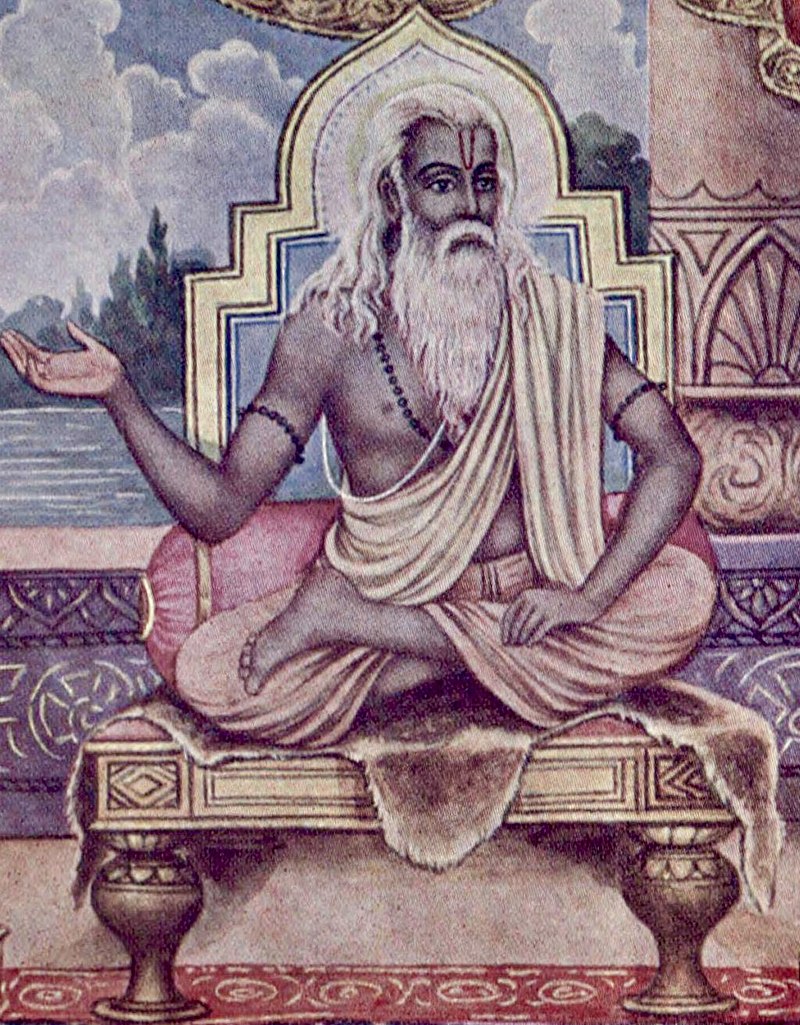Vyas Muni is one of the finest scholars who created and organized almost all the ancient Indian scriptures and even wrote the world’s longest epic Mahabharat, with 100,000 verses.

The early life of Vyas Muni
Vyas was the son of Rishi Parashar and Satyavati – the daughter of a fisherman. His real name was Krishna Dwaipayan – Krishna because he had a black complexion. And Dwaipayan because he was born on an island in the Yamuna River. He was the great-grandson of Rishi Vasishtha. Vyas is known as the compiler of the ved. Hence, he received the title Ved Vyas. He also contributed immensely to the field of Astrology, and his Parashar Hora is considered to be the textbook of astrology.
The Creation of Ancient Indian Scriptures
He and his son Shuk Muni were considered to be the finest scholars of those times. Because of their efforts, the traditionally spoken knowledge of ved was arranged into volumes of different scriptures and made available to the common people.
He is also considered to be the author of 18 Puran, Yog Bhashya, Brahm Sutra, and Mahabharat – including the Bhagwad Gita. His life and contributions have been mentioned in Vishnu Puran, Skand Puran, Devi Bhagwat, numerous other Hindu scriptures, as well as Sikh & Buddhist Scriptures. It is believed that he narrated the Devi Bhagwat Puran to Janmejay – the son of King Parikshit, who becomes the king of Hastinapur after the war of Mahabharat.
After compiling and re-organizing the four ved, Vyas had given the responsibility of one ved each to his four disciples – Paila, Jaimini, Vaishampayana and Sumantu.
The festival of Guru Purnima is celebrated in honour of Vyas Muni.
The creation of Mahabharat Epic
Vyas Muni is believed to be the father of Pandu, Dhrutrashtra, Vidur, and Shuk Dev. It is natural that he writes the story of Mahabharat as it unfolds in front of his eyes. Their story is told by the world’s largest epic – containing more than 100,000 shlok.
He is regarded as the author-narrator of Mahabharat, while Bhagwan Ganesh is the one who writes it down. There is an interesting story regarding this task. Bhagwan Ganesh agrees to write Mahabharat with one mischievous condition that – Vyas must narrate it without any pause. Sharp Vyas understands it and puts a counter condition that Bhagwan Ganesh must write any verse only after understanding it first.
Vyas is considered to be one of the immortal beings. The other immortals are – Hanuman, Vibhishan, King Mahabali, Parshuram, Krupacharya, Ashwatthama, and Markandey Muni.
Vyas is also a popular surname in the Brahmin community in India. This community is mostly present in Haryana, Punjab, Uttar Pradesh, Rajasthan, and Gujarat states, as well as most of the major cities. They consider themselves to be the descendants of Vyas Muni.
There is a place called Ved Vyas Cave in Mana Village near Badrinath, Uttarakhand. Legends say that Ved Vyas and Bhagwan Ganesh sat together to complete this mammoth task of creating Mahabharat. And from this place, the Pandavs started moving towards the heaven when their lifetimes were over.
There is also a place called Vyas Muni Ji Ki Chhatri in Bundi town of Rajasthan, which hosts some archaeologically important relics and idols.